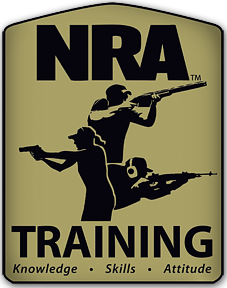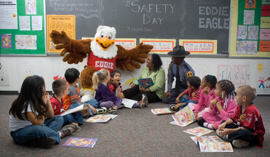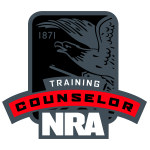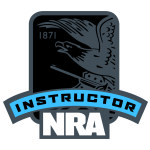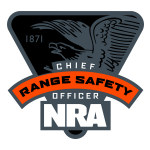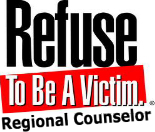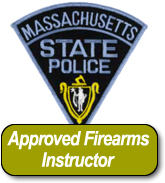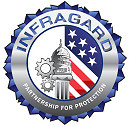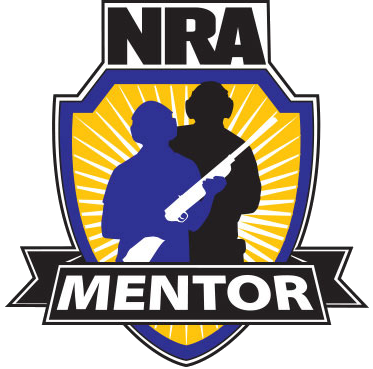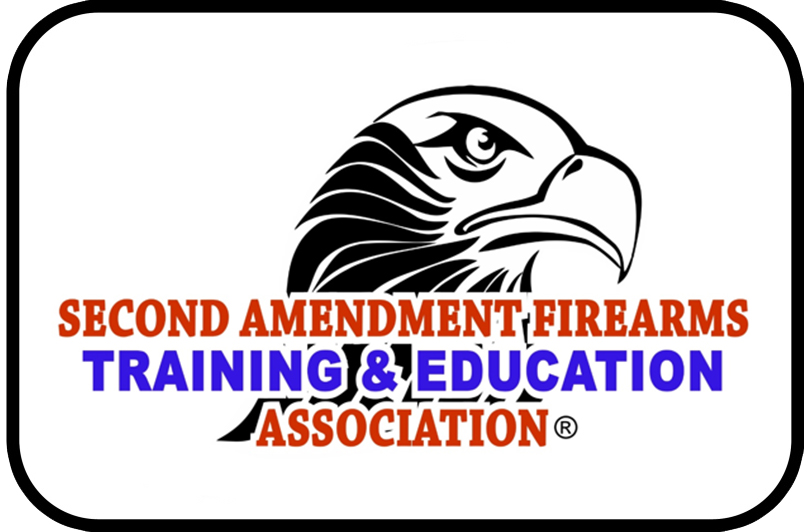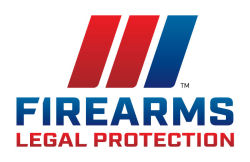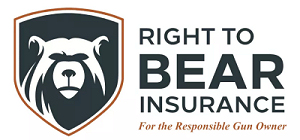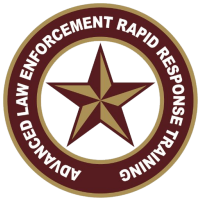Firearms Training NH - Course Catalog
Personal Firearms Instruction
So you want to learn how to shoot or just get some valuable pointers on how to improve your stance, grip, offhand shooting, accuracy etc and you want to do it privately. I can help, all you have to do is contact me and let me know what you want to learn or improve on such as pistol, rifle, shotgun, defensive pistol, concealed carry and more. Hourly rate is $75 per hour plus ammo cost, contact me today at This email address is being protected from spambots. You need JavaScript enabled to view it. - hope to hear from you soon. Please, if you buy a gun, take the steps to know how to operate it safely. It could save your life or the life of a loved one.
NRA Basic Pistol Course - LTC-002
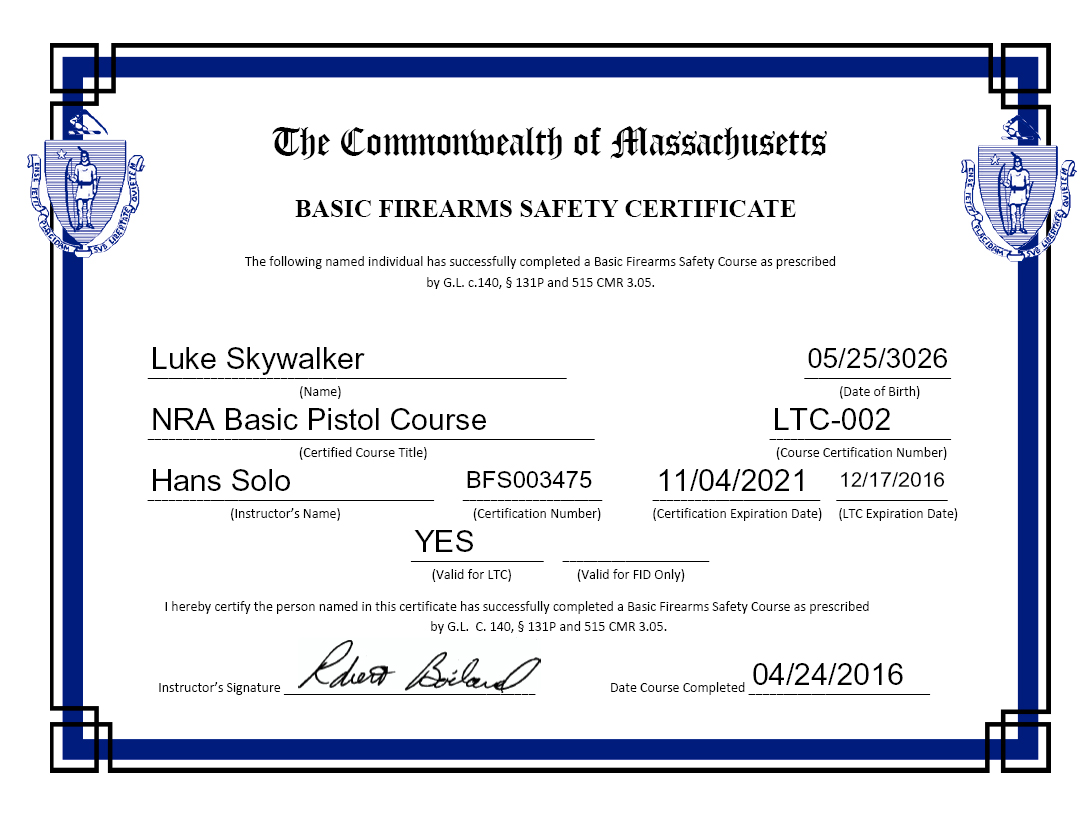
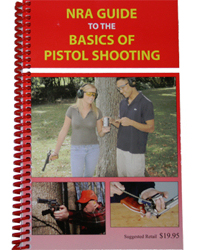 This course is at least 8-hours long and includes classroom and range time learning to shoot revolvers and semi-automatic pistols. Students learn NRA’s rules for safe gun handling; pistol parts and operation; ammunition; shooting fundamentals; range rules; shooting from the bench rest position, and two handed standing positions; cleaning the pistol; and continued opportunities for skill development. Students will receive the NRA Guide to the Basics of Pistol Shooting handbook, NRA Gun Safety Rules brochure, Winchester/NRA Marksmanship Qualification booklet, take a Basics of Pistol Shooting Student Examination, and course completion certificate.
This course is at least 8-hours long and includes classroom and range time learning to shoot revolvers and semi-automatic pistols. Students learn NRA’s rules for safe gun handling; pistol parts and operation; ammunition; shooting fundamentals; range rules; shooting from the bench rest position, and two handed standing positions; cleaning the pistol; and continued opportunities for skill development. Students will receive the NRA Guide to the Basics of Pistol Shooting handbook, NRA Gun Safety Rules brochure, Winchester/NRA Marksmanship Qualification booklet, take a Basics of Pistol Shooting Student Examination, and course completion certificate.
NRA Personal Protection In The Home Course - LTC-003

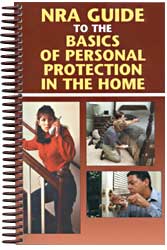 This is an eight-hour course. Students should expect to shoot approximately 100 rounds of ammunition. Students will learn basic defensive shooting skills, strategies for home safety and responding to a violent confrontation, firearms and the law, how to choose a handgun for self-defense, and continued opportunities for skill development. Students will receive the NRA Guide to the Basics of Personal Protection In The Home handbook, NRA Gun Safety Rules brochure, the Winchester/NRA Marksmanship Qualification booklet, and course completion certificate.
This is an eight-hour course. Students should expect to shoot approximately 100 rounds of ammunition. Students will learn basic defensive shooting skills, strategies for home safety and responding to a violent confrontation, firearms and the law, how to choose a handgun for self-defense, and continued opportunities for skill development. Students will receive the NRA Guide to the Basics of Personal Protection In The Home handbook, NRA Gun Safety Rules brochure, the Winchester/NRA Marksmanship Qualification booklet, and course completion certificate.
NRA Basic Personal Protection In The Home course is for law-abiding adult citizens, as defined by applicable federal, state, or local law, and experienced shooters (shooters able to show mastery of the basic skills of safe gun handling, shooting a group, zeroing the firearm, and cleaning the firearm) to maximize what can be learned from this course. Proof of shooting experience can be one of the following: NRA Basic Pistol Course Certificate, NRA FIRST Steps Course Certificate, NRA pistol competitive shooting qualification card, military DD 214 with pistol qualification, or passing the Pre-Course Assessment.
NRA Personal Protection Outside The Home Course
The course teaches students the knowledge, skills and attitude essential for avoiding dangerous confrontations and for the safe, effective and responsible use of a concealed pistol for self-defense outside the home. Students have the opportunity to attend this course using a quality strong side hip holster that covers the trigger, or a holster purse. From a review of safe firearms handling and proper mindset to presentation from concealment and multiple shooting positions, this course contains the essential skills and techniques needed to prevail in a life-threatening situation. 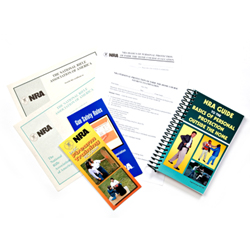 The NRA Personal Protection Outside the Home is divided into two levels (basic and advanced). Level one is a nine-hour course and offers the essential knowledge and skills that must be mastered in order to carry, store, and use a firearm safely and effectively for personal protection outside the home. Upon completion of level one, students may choose to attend level two, which is an additional five hours of range training and teaches advanced shooting skills.
The NRA Personal Protection Outside the Home is divided into two levels (basic and advanced). Level one is a nine-hour course and offers the essential knowledge and skills that must be mastered in order to carry, store, and use a firearm safely and effectively for personal protection outside the home. Upon completion of level one, students may choose to attend level two, which is an additional five hours of range training and teaches advanced shooting skills.
After the classroom portion, students should expect to spend several hours on the range and shoot approximately 100 rounds of ammunition during level one. Level two involves five additional hours on the range and approximately 115 rounds of ammunition. The ammunition requirements are minimum and may be exceeded. Students will receive the NRA Guide to the Basics of Personal Protection Outside The Home handbook, NRA Gun Safety Rules brochure and the appropriate course completion certificates(s), NRA Basic Personal Protection Outside The Home (identifies strong-side hip holster or purse use) certificate, and NRA Advanced Personal Protection Outside The Home certificate.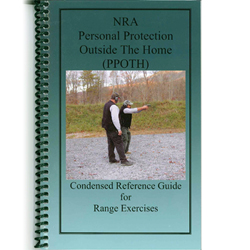 The NRA Basics of Personal Protection Outside The Home is for adult individuals who are not disqualified from possessing a firearm as defined by applicable federal, state, or local law and are of good repute and possess defensive pistol skills presented in the NRA Basics of Personal Protection In The Home Course. Participants must also understand the basic legal concepts relating to the use of firearms in self-defense, and must know and observe not only general gun safety rules, but also those safety principles that are specific to defensive situations. Prospective participants can demonstrate that they have the requisite knowledge, skills, and attitudes by producing an NRA Basic Personal Protection In The Home Course Certificate, or by passing the pre-course evaluation.
The NRA Basics of Personal Protection Outside The Home is for adult individuals who are not disqualified from possessing a firearm as defined by applicable federal, state, or local law and are of good repute and possess defensive pistol skills presented in the NRA Basics of Personal Protection In The Home Course. Participants must also understand the basic legal concepts relating to the use of firearms in self-defense, and must know and observe not only general gun safety rules, but also those safety principles that are specific to defensive situations. Prospective participants can demonstrate that they have the requisite knowledge, skills, and attitudes by producing an NRA Basic Personal Protection In The Home Course Certificate, or by passing the pre-course evaluation.
Note: Lesson III of the Personal Protection In and Outside the Home courses "Firearms and the Law", and Legal Aspects of Self-Defense is conducted by an attorney licensed to practice law within the state in which this course is given and who is familiar with this area of the law, or a Law Enforcement Officer (LEO) who possesses an intermediate or higher Peace Officer Standards and Training (POST) certificate granted within the state, or an individual currently certified to instruct in this area of the law by the state in which this course is presented.
NRA Defensive Pistol
 The NRA Defensive Pistol Course will focus on the techniques needed to develop a defensive mindset. The goal of the course will be to develop the knowledge, skills, and attitude necessary to carry and use a concealed pistol ethically, responsibly, and with confidence. As a result of participating in this course, the student will be able to explain and demonstrate the following: How to apply the NRA Rules for Safe Gun Handling when carrying a concealed firearm, basic principles of concealment, the difference between cover and concealment, drawing from the holster, levels of mental awareness, developing the proper mindset when using a pistol for personal protection, clearing common stoppages, and more.
The NRA Defensive Pistol Course will focus on the techniques needed to develop a defensive mindset. The goal of the course will be to develop the knowledge, skills, and attitude necessary to carry and use a concealed pistol ethically, responsibly, and with confidence. As a result of participating in this course, the student will be able to explain and demonstrate the following: How to apply the NRA Rules for Safe Gun Handling when carrying a concealed firearm, basic principles of concealment, the difference between cover and concealment, drawing from the holster, levels of mental awareness, developing the proper mindset when using a pistol for personal protection, clearing common stoppages, and more.
Course Length: Approximately 5 hours
The following topics will be reviewed in the course:
- The importance of carrying and using a pistol responsibly and ethically for personal protection
- How the NRA Rules for Safe Gun Handling are applied to concealed carry
- Basic principles of concealment
- Presenting a pistol - reholster
- Mental awareness
- Mental preparation to develop a defensive mindset for carrying and using a pistol for personal
protection
- Techniques for avoiding life-threatening confrontations
- Explain the psychological and physiological changes that may occur during an attack
- Flash sight picture
- Reloading under stress
- Clear common stoppages
- Cover and concealment
- Presenting a pistol from concealment and shoot targets at varying distances
- .....and more
Participant equipment requirements:
- Pistol- minimum calibers, .38 Special or 9mm.
- Three magazines or speed loaders
- Strong side holster; magazine holders or speed loader pouch
- Minimum 200 rounds of factory ammunition
- Clothing appropriate for concealed carry
- Eye and ear protection
Course Pre-requisites:
- NRA Basic Pistol, NRA FIRST Steps Pistol course or other certified pistol training
- Participant must be 21 years of age or older
Available Spring 2014
NRA Basic Rifle Course - FID-001

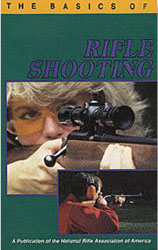 This course includes classroom and range time learning to shoot rifles. Students learn NRA’s rules for safe gun handling; rifle parts and operation; ammunition; shooting fundamentals; range rules; shooting from the bench rest, prone, sitting, standing and kneeling positions; cleaning, and continued opportunities for skill development. Students will receive the Basics of Rifle Shooting handbook, NRA Gun Safety Rules brochure, Winchester/NRA Marksmanship Qualification booklet, take a Basics of Rifle Shooting Student Examination, and course completion certificate.
This course includes classroom and range time learning to shoot rifles. Students learn NRA’s rules for safe gun handling; rifle parts and operation; ammunition; shooting fundamentals; range rules; shooting from the bench rest, prone, sitting, standing and kneeling positions; cleaning, and continued opportunities for skill development. Students will receive the Basics of Rifle Shooting handbook, NRA Gun Safety Rules brochure, Winchester/NRA Marksmanship Qualification booklet, take a Basics of Rifle Shooting Student Examination, and course completion certificate.
NRA Basic Shotgun Shooting Course
NRA FIRST Steps Rifle
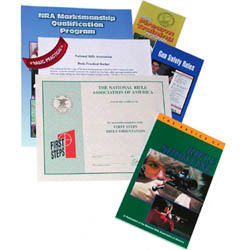 NRA FIRST Steps Rifle is designed to provide a hands-on introduction to the safe handling and proper orientation to one specific rifle action type for classes of four or fewer students. This course is at least three hours long and includes classroom and range time learning to shoot a specific rifle action type. Students will learn the NRA’s rules for safe gun handling; the particular rifle model parts and operation; ammunition; shooting fundamentals; cleaning the rifle; and continued opportunities for skill development. Students will receive the Basics of Rifle Shooting handbook, NRA Gun Safety Rules brochure, Winchester/NRA Marksmanship Qualification booklet, FIRST Steps Course completion certificate.
NRA FIRST Steps Rifle is designed to provide a hands-on introduction to the safe handling and proper orientation to one specific rifle action type for classes of four or fewer students. This course is at least three hours long and includes classroom and range time learning to shoot a specific rifle action type. Students will learn the NRA’s rules for safe gun handling; the particular rifle model parts and operation; ammunition; shooting fundamentals; cleaning the rifle; and continued opportunities for skill development. Students will receive the Basics of Rifle Shooting handbook, NRA Gun Safety Rules brochure, Winchester/NRA Marksmanship Qualification booklet, FIRST Steps Course completion certificate.
NRA Home Firearm Safety Course - LTC-007

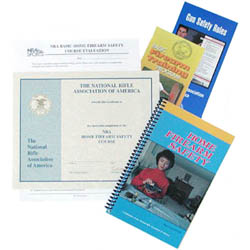 Non-shooting course and teaches students the basic knowledge, skills, and to explain the attitude necessary for the safe handling and storage of firearms and ammunition in the home.
Non-shooting course and teaches students the basic knowledge, skills, and to explain the attitude necessary for the safe handling and storage of firearms and ammunition in the home.
This is a four-hour course for safe gun handling that is conducted in the classroom only. Students are taught NRA’s three rules for safe gun handling; primary causes of firearms accidents; firearm parts; how to unload certain action types; ammunition components; cleaning; care; safe storage of firearms in the home; and the benefits of becoming an active participant in the shooting sports. Students will receive the NRA Home Firearm Safety handbook, NRA Gun Safety Rules brochure, Basic Firearm Training Program brochure, course completion certificate
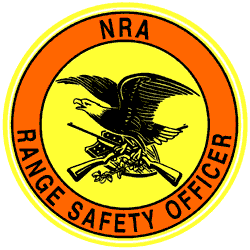 NRA Range Safety Officer
NRA Range Safety Officer
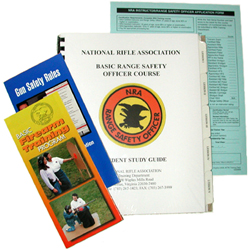 This course is nine hours long and is conducted in a classroom and may include a Range facility. NRA Range Safety Officer candidates will learn roles and responsibilities of an RSO; Range Standard Operating Procedures (SOPs); range inspection; range rules; range briefings; emergency procedures; and firearm stoppages and malfunctions. Each Range Safety Officer Candidate will receive an RSO Student Study Guide, a Basic Firearm Training Program brochure, an NRA Gun Safety Rules brochure, an Instructor Application/Course Evaluation form.
This course is nine hours long and is conducted in a classroom and may include a Range facility. NRA Range Safety Officer candidates will learn roles and responsibilities of an RSO; Range Standard Operating Procedures (SOPs); range inspection; range rules; range briefings; emergency procedures; and firearm stoppages and malfunctions. Each Range Safety Officer Candidate will receive an RSO Student Study Guide, a Basic Firearm Training Program brochure, an NRA Gun Safety Rules brochure, an Instructor Application/Course Evaluation form.
The Use of Force & Law
If you own a gun for personal or home protection or carry a firearm for personal protection in New Hampshire you're going to want to take this class. In this class we will discuss the law aspects of firearms and personal protection, the use of lethal force in and outside the home, the force on force continuum and how it applies to private citizens, protection of other people and much more. Look for the class schedule soon.
(Course Length 4 - 5 Hours).
What we will cover in this course:
- Permits & Licensing
- NH State Law vs. Federal Laws
- Traveling with your firearm (Autos, Planes, Mass Transit)
- Use of Lethal Force
- Force on Force Continuum
- Selling and Buying guns, private sales, interstate
- Home Defense
- Concealed & Open Carry
- Ability, Opportunity, Manifest Jeopardy, and Preclusion
- Doctrine of Competing Harms
- Class III Firearms
- NFA Trust
- Transportation of Firearms
- The aftermath of a defensive shooting and what to do.
- Dealing with the Police
- Defense Insurance
- Firearms Owners Protection Act (FOPA)
- Preemptions Laws and How they apply
- Emergency Powers Act
- NH Stand your Ground Law
- The Castle Doctrine
- What is Justifiable Homicide
- Where you can legally carry and where you can't.
- How Fish & Game laws also apply to you.
- Pistols, Shotguns & Rifles
- And Much More.
NRA Basic Metallic Cartridge Reloading Course
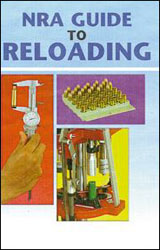 Teaches beginning reloaders the basic knowledge, skills, and attitude necessary to safely reload metallic cartridges. This course is eight hours in length and is conducted in a classroom. Each student is taught reloading safety; centerfire cartridge components; using the reloading manual and reloading data; equipment; and the metallic cartridge reloading process. Students will receive the NRA Guide to Reloading handbook, the Basic Reloading Student Exam, a course completion certificate, NRA Gun Safety Rules brochure, a Basic Firearm Training Program brochure, an Instructor Application/Course Evaluation form.
Teaches beginning reloaders the basic knowledge, skills, and attitude necessary to safely reload metallic cartridges. This course is eight hours in length and is conducted in a classroom. Each student is taught reloading safety; centerfire cartridge components; using the reloading manual and reloading data; equipment; and the metallic cartridge reloading process. Students will receive the NRA Guide to Reloading handbook, the Basic Reloading Student Exam, a course completion certificate, NRA Gun Safety Rules brochure, a Basic Firearm Training Program brochure, an Instructor Application/Course Evaluation form.
NRA Basic Shotgun Shell Reloading Course
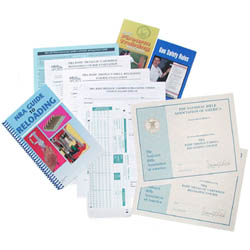 Teaches beginning reloaders the basic knowledge, skills, and attitude necessary to safely reload shotgun shells. This course is six hours in length and is conducted in a classroom. Each student is taught reloading safety; shotgun shell components; using the reloading manual and reloading data; equipment; and the shotgun shell reloading process. Students will receive the NRA Guide to Reloading handbook, the Basic Reloading Student Exam, a course completion certificate, NRA Gun Safety Rules brochure, a Basic Firearm Training Program brochure, an Instructor Application Course/Evaluation form.
Teaches beginning reloaders the basic knowledge, skills, and attitude necessary to safely reload shotgun shells. This course is six hours in length and is conducted in a classroom. Each student is taught reloading safety; shotgun shell components; using the reloading manual and reloading data; equipment; and the shotgun shell reloading process. Students will receive the NRA Guide to Reloading handbook, the Basic Reloading Student Exam, a course completion certificate, NRA Gun Safety Rules brochure, a Basic Firearm Training Program brochure, an Instructor Application Course/Evaluation form.
USCCA Concealed Carry and Home Defense Fundamentals
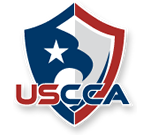 The "Concealed Carry and Home Defense Fundamentals Course," is a comprehensive seminar for anyone considering owning or carrying a firearm for self defense. The class is a non-shooting class and is approx 8 hours long. In this seminar you will learn conflict avoidance, situational awareness; handgun, shotgun & AR-15 basics; shooting fundamentals; the physiology of violent encounters, legal aspects of using deadly force (including knowing what to do in the aftermath); and a complete guide on gear, gadgets, and ongoing training.
The "Concealed Carry and Home Defense Fundamentals Course," is a comprehensive seminar for anyone considering owning or carrying a firearm for self defense. The class is a non-shooting class and is approx 8 hours long. In this seminar you will learn conflict avoidance, situational awareness; handgun, shotgun & AR-15 basics; shooting fundamentals; the physiology of violent encounters, legal aspects of using deadly force (including knowing what to do in the aftermath); and a complete guide on gear, gadgets, and ongoing training.
This mid level Course uses curriculum developed by renowned Firearms Trainer and USCCA Vice President, Michael Martin. This multi-faceted course includes training from Michael Martin's 'Concealed Carry and Home Defense Fundamentals'. This course advances the mindset for the responsible defensive firearms owner by focusing on and understanding conflict avoidance and situational awareness; handgun & shotgun basics; shooting fundamentals; the Physiology of violent encounters; the legal aspects of the use of deadly force (including knowing what to do in the aftermath; and a complete guide on gear, gadgets, and ongoing training.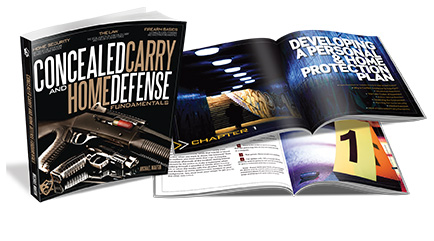 $125 Course fee includes: 8 hours of Classroom Instruction, Course materials including a copy of Michael Martin's 200+ page training manual "Concealed Carry & Home Defense Fundamentals" (a $31.95 Value!). A Course Completion Certificate will be awarded to all participants who successfully complete the course.
$125 Course fee includes: 8 hours of Classroom Instruction, Course materials including a copy of Michael Martin's 200+ page training manual "Concealed Carry & Home Defense Fundamentals" (a $31.95 Value!). A Course Completion Certificate will be awarded to all participants who successfully complete the course.
Topics include developing your own personal and home protection plan, firearm basics, shooting fundamentals, legal use of force, physiology of violent encounters, dealing with the aftermath, and gear selection.

Lesson Topics Include:
Lesson One: DEVELOPING A PERSONAL & HOME PROTECTION PLAN
» Why is Conflict Avoidance so Important?
» Situational Awareness
» The Color Codes of Awareness
» Observing our Environments
» More on Conflict Avoidance
» Planning for Home Defense
» Mental Exercises
Lesson Two: SELF-DEFENSE FIREARMS BASICS
» Four Universal Safety Rules
» Properly Clearing Semi-Automatics and Revolvers
» Additional Safety Considerations
» Double Action versus Single Action
» Revolver and Semi-Automatic Examples
» Other Considerations
» Ammunition Malfunctions
» Understanding Ammunition, Ballistics, Take Down Factor, Gauge & Calibers
» An Introduction to Home Defense Shotguns, and the AR-15 Platform
» Tasers and Pepper Spray
Lesson Three: DEFENSIVE SHOOTING FUNDAMENTALS
» Muscle Memory
» Proper Grip
» Stance: Body and Arm Positions
» Point Shooting
» Sight Shooting
» Flash Sight Picture
» Trigger Control
Lesson Four: The Legal Use of Force
» Legal Definitions of Reasonable Force and Deadly Force
» Understanding the Use of Force Continuum
» The Legal Use of Deadly Force
» Defense in the Home
» Defending Property
Lesson Five: Violent Encounters and Their Aftermath
» Understanding Fight or Flight
» The Physiological Reactions Associated with Extreme Stress
» When We’re Left with No Other Choice
» When the Right to use Deadly Force Ends
» The Immediate Aftermath
» Dealing with the Police
Lesson Six: Gear and Gadgets
» Explaining Holster Retention
» Types of Holsters
» Other Gear Including Belts, Lights and Lasers
Lesson Seven: Basic and Advanced Skills
» Properly and Safely Conducting Dry Fire Exercises
» Self-Led and Instructor-Led Range Exercises from Beginner to Expert
» What’s Next?
NRA Eddie Eagle GunSafe Program
What is The Eddie Eagle GunSafe® Program?
The Eddie Eagle GunSafe® Program teaches children in pre-K through third grade four important steps to take if they find a gun. These steps are presented by the program's mascot, Eddie Eagle, in an easy-to-remember format consisting of the following simple rules:
STOP!
Don't Touch.
Leave the Area.
Tell an Adult.
Begun in 1988, The Eddie Eagle GunSafe® Program has reached more than 26 million children - in all 50 states. This program was developed through the combined efforts of such qualified professionals as clinical psychologists, reading specialists, teachers, curriculum specialists, urban housing safety officials, and law enforcement personnel. Anyone may teach The Eddie Eagle GunSafe® Program, and NRA membership is not required. The program may be readily incorporated into existing school curriculum, taught in a one- to five-day format, and used to reach both levels or simply one or two grades. Materials available through this program are: student workbooks, 7-minute animated DVD, instructor guides, brochures, and student reward stickers. Program materials are also available in Spanish.
Anyone may teach The Eddie Eagle GunSafe® Program, and NRA membership is not required. The program may be readily incorporated into existing school curriculum, taught in a one- to five-day format, and used to reach both levels or simply one or two grades. Materials available through this program are: student workbooks, 7-minute animated DVD, instructor guides, brochures, and student reward stickers. Program materials are also available in Spanish.
The NRA is committed to helping keep America's young children safe. In efforts to do so, we offer our program at a nominal fee. Schools, law enforcement agencies, hospitals, daycare centers, and libraries may be eligible to receive grant funding to defray program costs. Grant funding is available in many states to these groups to cover the cost of all program curriculum materials.
The purpose of the Eddie Eagle Program isn't to teach whether guns are good or bad, but rather to promote the protection and safety of children. The program makes no value judgments about firearms, and no firearms are ever used in the program. Like swimming pools, electrical outlets, matchbooks and household poison, they're treated simply as a fact of everyday life. With firearms found in about half of all American households, it's a stance that makes sense.
Eddie Eagle is never shown touching a firearm, and he does not promote firearm ownership or use. The program prohibits the use of Eddie Eagle mascots anywhere that guns are present. The Eddie Eagle Program has no agenda other than accident prevention - ensuring that children stay safe should they encounter a gun. The program never mentions the NRA. Nor does it encourage children to buy guns or to become NRA members. The NRA does not receive any appropriations from Congress, nor is it a trade organization. It is not affiliated with any firearm or ammunition manufacturers or with any businesses that deal in guns and ammunition.
For more information on the Eddie Eagle GunSafe® Program please see https://eddieeagle.nra.org/
SAFTD Officer LEO Program®
 The Officer LEO Programis taught to children from pre-K through 3rd grade and educates our younger friends about firearms inside and outside the home. The kids will learn what to do if they encounter a gun and how to handle the situation correctly. Officer LEO also teaches about general safety and how to stay safe when away from parents or guardians.
The Officer LEO Programis taught to children from pre-K through 3rd grade and educates our younger friends about firearms inside and outside the home. The kids will learn what to do if they encounter a gun and how to handle the situation correctly. Officer LEO also teaches about general safety and how to stay safe when away from parents or guardians.
The Officer LEO Program will also answer many questions that parents may have about children & firearms safety and keeping your kids safe at home and away from home.
SAFTD S.A.F.E Situational Alertness for Everyone
 The Situational Alertness for Everyone (S.A.F.E.) course is designed to teach the student to develop and adopt the situational awareness mindset while at home, at work, on the road, traveling, on the phone etc; and teaches how to make your home safe and less attractive to would be robbers and home invasion.
The Situational Alertness for Everyone (S.A.F.E.) course is designed to teach the student to develop and adopt the situational awareness mindset while at home, at work, on the road, traveling, on the phone etc; and teaches how to make your home safe and less attractive to would be robbers and home invasion.
This course is packed with home safety tips do's and don'ts, such as how to build a safe room or multiple safe rooms in your house, building layers of security and how to survive a violent encounter in your home. We'll also cover outside lighting, landscaping, the 6 second garage door entry, bump keys and more.
The SAFE Course will also cover the levels of awareness as developed by Jeff Cooper and will teach you the mindset of living in a relaxed but aware state of condition yellow and discuss when your alertness level should change based on your current situation.
 Some of the topics that will be discussed are:
Some of the topics that will be discussed are:
- The Criminal Mindset
- How criminals select their victims
- Creating a Safe Room & Home Security Plan
- Situational Awareness and Avoidance
Techniques - Internet and Cyber Safety
- Home & Phone Security
- Carjack Avoidance Techniques
- Automobile & Travel Security
- Personal Boundaries
- Personal & Cyber Security
- Personal Defense Devices (Tasers, Stun Guns, Batons, Pepper Spray)
- Personal Safety Tools (Alarms, Whistles, Cell Phones etc)
- What to do in case of a Home Invasions and/or Burglary
- Interacting with the Police
- How to stop Sliders in their tracks
- Bump Keys and Prevention
- Security Window Film
- The 6 second garage door break-in and how to prevent it.
- Malls & Parking Garages safety concerns
- Layers of Defense and making your home a hard target.
- Mental Preparedness & Controlling Fear
- Lighting, Alarms, Dead Bolts, Windows and more
- Rape Statistics and Prevention
- Banking & ATM Scams
- Cyber-fraud & Electronic Theft
- Cyber-stalking & Cyber-bullying
- Identity Theft
- Workplace Security
The S.A.F.E. Course provides the knowledge to enable course participates to stay safe, avoid conflicts, mentally prepare and create a personal safety plan for you and your family no matter where you are and to control the encounter should you happened to find yourself in a violent situation.
Other modules that maybe included in the seminar dependent on course participates are:
- S.A.F.E. at Work Module,
- S.A.F.E. at Schools & College Module
- S.A.F.E. Seniors Module
- S.A.F.E. Handicapped & Disabled Module
- S.A.F.E. Domestic Violence & Stalking Module
SAFTD Defensive Handgun 1
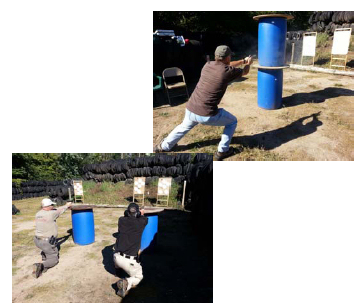 The goal of the Second Amendment Foundation Training Division's “Defensive Handgun 1” course is to provide the student with a solid foundation in basic knowledge of handgun safety, various types of handguns, an understanding of ammunition and how it functions, shooting fundamentals and an introduction to defensive shooting skills.
The goal of the Second Amendment Foundation Training Division's “Defensive Handgun 1” course is to provide the student with a solid foundation in basic knowledge of handgun safety, various types of handguns, an understanding of ammunition and how it functions, shooting fundamentals and an introduction to defensive shooting skills.
A student new to the use of a firearm for personal defense typically has a broad range of questions and is faced with learning a number of skills that are critical in the use of a firearm – in this case a handgun – to defend themselves, their family or someone in their charge. Defensive Handgun 1 is specifically designed to provide a person new to handguns the opportunity to gain that knowledge and learn those skills.
A number of topics will be covered in “Defensive Handgun 1 – Introduction to the Defensive Use of a Handgun”. These include but are not limited to:
- Safe handling of your firearm.
- Safe Storage of your firearm and ammunition.
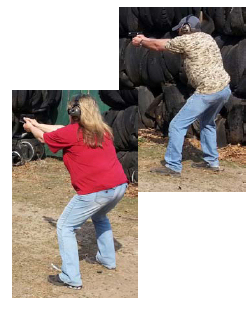 Basic components of a Double Action Revolver.
Basic components of a Double Action Revolver.- Basic components of a Semi-Automatic Pistol
- Operation of a Double– Action Revolver
- Operation of a Single and a Double Action Semi-Automatic Pistol.
- Working With A Natural Defensive Stance
- 2-Handed and Single Handed Engagements
- Integrating The Color Code Into Your Life
- Finding Your Balance of Speed and Precision
- Clearing Common Pistol Stoppages
- Progressive Shooting Drills
- Definition of Cover and Concealment
- Use of Cover
- Shooting From Low and High Barricades
- Selecting a Pistol and Ammunition
- Cleaning and Maintain your Pistols
SAFTD Defensive Handgun 2
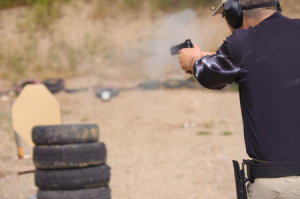 The goal of the Second Amendment Foundation Training Division's Defensive Handgun 2 Course is to provide the student with an opportunity to build upon the foundational skill-set and knowledge base that was acquired in Defensive Handgun 1. This will include a continued focus on the defensive mindset, and the development of marksmanship and gun handling skills needed to safely and effectively carry a concealed handgun for personal self defense.
The goal of the Second Amendment Foundation Training Division's Defensive Handgun 2 Course is to provide the student with an opportunity to build upon the foundational skill-set and knowledge base that was acquired in Defensive Handgun 1. This will include a continued focus on the defensive mindset, and the development of marksmanship and gun handling skills needed to safely and effectively carry a concealed handgun for personal self defense.
Students will become adept at working with the handgun from the holster, including drawing safely, efficiently, and quickly, and safely re-holstering. You will learn to shoot quickly but accurately, fire multiple shots with full control and will learn to reload the pistol quickly and efficiently using both speed reloads and emergency reloads. Students will learn to shoot effectively with one hand, using the dominant hand and/or the non-dominant hand. We will work on mental conditioning to prepare the student to effectively deal with a sudden threat to their life or the life of another.
Defensive Handgun 2 is designed to help the student quickly develop essential skills that can help him/her prevail in a real lethal force encounters.
Defensive Handgun 2 consists of a full day of intense classroom & range training and instruction covering a variety of topics including, but not limited to:
- Gun Safety Rules and Trigger Finger & Muzzle Discipline
- The importance of the Defensive Mindset
- Review of Defensive Shooting Fundamentals
- Dry fire & Live Fire Exercises
- Presentation from a holster
- Emergency and Speed Reloads
- Fighting stance platform
- Delivering Multiple Shots efficiently and on target
- Trigger Reset
- The IALEFI-QP Silhouette Target
- Introduction to One-Hand Only Presentation and Shooting
SAFTD Defensive Carbine 1
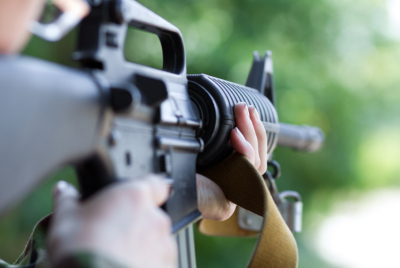 The goal of the Second Amendment Foundation Training Division's “Defensive Carbine 1” course is to provide the student with a solid foundation in basic knowledge of carbine safety, various types of carbines, an understanding of ammunition and how it functions, shooting fundamentals and an introduction to defensive shooting skills.
The goal of the Second Amendment Foundation Training Division's “Defensive Carbine 1” course is to provide the student with a solid foundation in basic knowledge of carbine safety, various types of carbines, an understanding of ammunition and how it functions, shooting fundamentals and an introduction to defensive shooting skills.
A person new to the use of a firearm for personal defense typically has a broad range of questions and is faced with learning a number of skills that are critical in the use of a firearm – in this case a Carbine – to defend themselves, their family or someone in their charge. Defensive Carbine 1 is specifically designed to provide a person new to carbines the opportunity to gain that knowledge and learn those skills.
A number of topics will be covered in “Defensive Carbine 1 - Introduction to the Defensive Use of a Carbine. These include but are not limited to:
- Safe handling of your firearm.
- Safe Storage of your firearm and ammunition.
- Basic components of a Carbine
- Types and Operation of various Carbines.
- Working With A Natural Defensive Stance
- Integrating The Color Code Into Your Life
- Finding Your Balance of Speed and Precision
- Clearing Common Stoppages
- Progressive Shooting Drills
- Definition of Cover and Concealment
- Use of Cover
- Shooting From Low and High Barricades
- Selecting a Carbine and Ammunition
- Cleaning and Maintain your Carbines
SAFTD Defensive Carbine 2
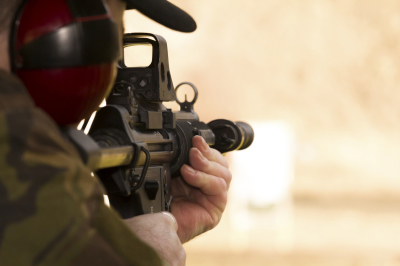 The goal of the Second Amendment Foundation Training Division’s Defensive Carbine 2 Course is to provide the student with an opportunity to build upon the foundational skill-set and knowledge base that was acquired in Defensive Carbine 1. This will include a continued focus on the defensive mindset, discussion regarding avoidance/deescalation strategies, an understanding of the physiological changes that occur in the human body when under lethal force stress and what affect they have on our training, and a series of skill development exercises that will help the student learn to more efficiently and effectively use a carbine for self defense in a lethal force encounter.
The goal of the Second Amendment Foundation Training Division’s Defensive Carbine 2 Course is to provide the student with an opportunity to build upon the foundational skill-set and knowledge base that was acquired in Defensive Carbine 1. This will include a continued focus on the defensive mindset, discussion regarding avoidance/deescalation strategies, an understanding of the physiological changes that occur in the human body when under lethal force stress and what affect they have on our training, and a series of skill development exercises that will help the student learn to more efficiently and effectively use a carbine for self defense in a lethal force encounter.
Defensive Carbine 2 is not a “marksmanship” or “target shooting” course. Rather it is designed to help the student quickly develop essential skills that can help him/her prevail in a real lethal force encounter.
Defensive Carbine 2 consists of a full day of intense range training and instruction covering a variety of topics including, but not limited to:
- Avoidance and deescalation strategies
- The importance of the Defensive Mindset
- Physiological changes that occur when under severe stress
- Review of Defensive Shooting Fundamentals
- Defensive Accuracy Concept
- Volume of Fire
- Using lateral movement
- Presentation of the Carbine
- Emergency and Tactical Reloads
- Proper Scan and Assess procedure
- Malfunction Clearing Remedies
- Engaging Multiple Targets
- Moving to Cover and/or Concealment
- Application of learned skills under realistic conditions
SAFTD Defensive Shotgun 1
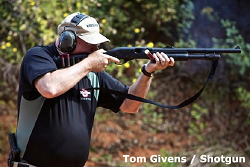 The goal of the Second Amendment Foundation Training Division's “Defensive Shotgun 1” course is to provide the student with a solid foundation in basic knowledge of shotgun safety, various types of shotgun, an understanding of ammunition and how it functions, shooting fundamentals and an introduction to defensive shooting skills.
The goal of the Second Amendment Foundation Training Division's “Defensive Shotgun 1” course is to provide the student with a solid foundation in basic knowledge of shotgun safety, various types of shotgun, an understanding of ammunition and how it functions, shooting fundamentals and an introduction to defensive shooting skills.
A person new to the use of a firearm for personal defense typically has a broad range of questions and is faced with learning a number of skills that are critical in the use of a firearm – in this case a shotgun – to defend themselves, their family or someone in their charge. Defensive Shotgun 1 is specifically designed to provide a person new to shotguns the opportunity to gain that knowledge and learn those skills.
A number of topics will be covered in “Defensive Shotgun 1 - Introduction to the Defensive Use of a Shotgun. These include but are not limited to:
- Safe handling of your firearm.
- Safe Storage of your firearm and ammunition.
- Basic components of a shotgun
- Types and Operation of shotguns including pump, semi-automatic, break-open, etc.
- Working With A Natural Defensive Stance
- Integrating The Color Code Into Your Life
- Finding Your Balance of Speed and Precision
- Clearing Common Stoppages
- Progressive Shooting Drills
- Definition of Cover and Concealment
- Use of Cover
- Shooting From Low and High Barricades
- Selecting a Shotgun and Ammunition
- Cleaning and Maintain your Shotguns
SAFTD Defensive Shotgun 2
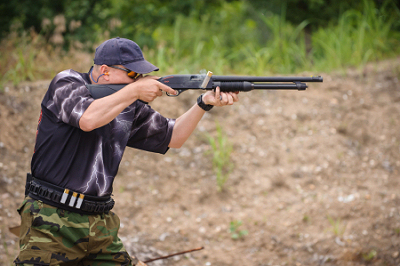 The goal of the Second Amendment Foundation Training Division’s Defensive Shotgun 2 Course is to provide the student with an opportunity to build upon the foundational skill-set and knowledge base that was acquired in Defensive Shotgun 1. This will include a continued focus on the defensive mindset, discussion regarding avoidance/deescalation strategies, an understanding of the physiological changes that occur in the human body when under lethal force stress and what affect they have on our training, and a series of skill development exercises that will help the student learn to more efficiently and effectively use a shotgun for self defense in a lethal force encounter.
The goal of the Second Amendment Foundation Training Division’s Defensive Shotgun 2 Course is to provide the student with an opportunity to build upon the foundational skill-set and knowledge base that was acquired in Defensive Shotgun 1. This will include a continued focus on the defensive mindset, discussion regarding avoidance/deescalation strategies, an understanding of the physiological changes that occur in the human body when under lethal force stress and what affect they have on our training, and a series of skill development exercises that will help the student learn to more efficiently and effectively use a shotgun for self defense in a lethal force encounter.
Defensive Shotgun 2 is not a “marksmanship” or “target shooting” course. Rather it is designed to help the student quickly develop essential skills that can help him/her prevail in a real lethal force encounter.
Defensive Shotgun 2 consists of a full day of intense range training and instruction covering a variety of topics including, but not limited to:
- Avoidance and deescalation strategies
- The importance of the Defensive Mindset
- Physiological changes that occur when under severe stress
- Review of Defensive Shooting Fundamentals
- Defensive Accuracy Concept
- Volume of Fire
- Using lateral movement
- Presentation of the Shotgun
- Emergency and Tactical Reloads
- Proper Scan and Assess procedure
- Malfunction Clearing Remedies
- Engaging Multiple Targets
- Moving to Cover and/or Concealment
- Application of learned skills under realistic conditions
SAFTD Women's Defensive Handgun 1
 The goal of the Second Amendment Foundation Training Division's Women's Defensive Handgun 1 course is to provide the women with a solid foundation in basic knowledge of handgun safety, types of handguns, understanding ammunition and how it functions, shooting fundamentals and an introduction to defensive shooting skills. This class also addresses specific women issues when carrying a firearm for personal protection. Covered also are selection of an appropriate defensive firearm and holster, concealed carry clothing, security and special concerns with carrying a firearm both on and off-body.
The goal of the Second Amendment Foundation Training Division's Women's Defensive Handgun 1 course is to provide the women with a solid foundation in basic knowledge of handgun safety, types of handguns, understanding ammunition and how it functions, shooting fundamentals and an introduction to defensive shooting skills. This class also addresses specific women issues when carrying a firearm for personal protection. Covered also are selection of an appropriate defensive firearm and holster, concealed carry clothing, security and special concerns with carrying a firearm both on and off-body.
A woman new to the use of a firearm for personal defense, typically has a broad range of questions and is faced with learning a number of skills that are critical in the use of a firearm – in this case a handgun – to defend themselves, their family or someone in their charge. Women's Defensive Handgun 1 is specifically designed to provide a person new to handguns the opportunity to gain that knowledge and learn those skills.
A number of topics will be covered in Women's Defensive Handgun 1 – Introduction to the Defensive Use of a Handgun.
Topics include but are not limited to:
- Safe handling of your firearm.
- Safe storage of your firearm and ammunition.
- Basic components of a double-action revolver.
- Basic components of a semi-automatic pistol.
- Operation of a double-action revolver.
- Operation of a single and a double-action semi-automatic pistol.
- Selecting a pistol and ammunition.
- Working from a defensive stance.
- Finding your balance of speed and precision.
- Clearing common pistol stoppages.
- Progressive shooting drills.
- Integrating The Color Code into your life.
- Deadly force definition and legal matters.
- Definition of cover and concealment.
- Cleaning and maintain your pistol.
SAFTD Women's Defensive Handgun 2
The goal of the Second Amendment Training Division’s Women's Defensive Handgun 2 course is to provide women with an opportunity to build upon the foundational skill-set and knowledge base that was acquired in Women's Defensive Handgun 1. This will include a continued focus on the defensive mindset and the development of marksmanship and gun handling skills needed to safely and effectively carry a concealed handgun for personal self-defense.
Students will become adept at working with the handgun from the holster, including presenting safely, efficiently, quickly and safely re-holstering. You will learn to shoot quickly but accurately, fire multiple shots with full control, learn to reload the pistol quickly and efficiently using both speed reloads and emergency reloads. Students will learn to shoot with one hand using the dominant hand and/or the non-dominant hand. We will work on mental conditioning to prepare the student to effectively deal with a sudden threat to their life or the life of another.
Women's Defensive Handgun 2 is designed to develop essential skills that can help her prevail in a lethal force encounter.
Topics include but are not limited to:
- Gun Safety Rules and trigger finger and muzzle discipline.
- The importance of the defensive mindset.
- Review of defensive shooting fundamentals.
- Dry fire and live fire exercises.
- Presentation from a holster.
- Emergency and speed reloads.
- Fighting stance/platform.
- Delivering multiple shots efficiently and on target.
- Trigger reset.
- The IALEFI-QP silhouette target.
- Introduction to one hand only presentation and shooting.
SAFTD F.A.S.T. Carbine
 The goal of the Second Amendment Foundation Training Division's “F.A.S.T Carbine” course is to provide the student with a solid foundation in basic knowledge of Carbine "Fundamentals and Safety Training" on your specific Carbine, a basic understanding of ammunition and how it functions as well as shooting fundamentals.
The goal of the Second Amendment Foundation Training Division's “F.A.S.T Carbine” course is to provide the student with a solid foundation in basic knowledge of Carbine "Fundamentals and Safety Training" on your specific Carbine, a basic understanding of ammunition and how it functions as well as shooting fundamentals.
A person new to the use of a firearm for personal defense typically has a broad range of questions and is faced with learning a number of skills that are critical in the safe use of a firearm – in this case a Carbine. F.A.S.T Carbine is specifically designed to provide a person new to Carbines the opportunity to gain that knowledge and learn the basics of operation, cleaning and maintenance, safety and much more in a convenient 4 hour course. “F.A.S.T Carbine” is also meant as an introductory course for students new to carbines prior to taking SAFTD Defensive Carbine 1.
A number of topics will be covered in “F.A.S.T Carbine”. These include but are not limited to:
-
 Safe handling of your firearm.
Safe handling of your firearm. - Gun Safety Rules
- Safe Storage of your firearm and ammunition.
- Basic components of a your Carbine
- Operation of your Carbine
- Shooting Fundamentals
- Clearing Common Carbine Stoppages
- Selecting a Carbine and Ammunition
- Cleaning and Maintain your Carbine
SAFTD F.A.S.T. Shotgun
 The goal of the Second Amendment Foundation Training Division's “F.A.S.T Shotgun” course is to provide the student with a solid foundation in basic knowledge of Shotgun "Fundamentals and Safety Training" on your specific Shotgun, a basic understanding of ammunition and how it functions as well as shooting fundamentals.
The goal of the Second Amendment Foundation Training Division's “F.A.S.T Shotgun” course is to provide the student with a solid foundation in basic knowledge of Shotgun "Fundamentals and Safety Training" on your specific Shotgun, a basic understanding of ammunition and how it functions as well as shooting fundamentals.
A person new to the use of a firearm for personal defense typically has a broad range of questions and is faced with learning a number of skills that are critical in the safe use of a firearm – in this case a Shotgun. F.A.S.T Shotgun is specifically designed to provide a person new to Shotguns the opportunity to gain that knowledge and learn the basics of operation, cleaning and maintenance, safety and much more in a convenient 4 hour course. “F.A.S.T Shotgun” is also meant as an introductory course for students new to shotguns prior to taking SAFTD Defensive Shotgun 1.
A number of topics will be covered in “F.A.S.T Shotgun”. These include but are not limited to:
- Safe handling of your firearm.
- Gun Safety Rules
- Safe Storage of your firearm and ammunition.
- Basic components of a your Shotgun
- Operation of your Shotgun
- Shooting Fundamentals
- Clearing Common Shotgun Stoppages
- Selecting a Shotgun and Ammunition
- Cleaning and Maintain your Shotgun
SAFTD F.A.S.T. Handgun
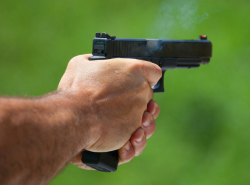 The goal of the Second Amendment Foundation Training Division's “F.A.S.T Handgun” course is to provide the student with a solid foundation in basic knowledge of handgun "Fundamentals and Safety Training" on your specific handgun, a basic understanding of ammunition and how it functions as well as shooting fundamentals.
The goal of the Second Amendment Foundation Training Division's “F.A.S.T Handgun” course is to provide the student with a solid foundation in basic knowledge of handgun "Fundamentals and Safety Training" on your specific handgun, a basic understanding of ammunition and how it functions as well as shooting fundamentals.
A person new to the use of a firearm for personal defense typically has a broad range of questions and is faced with learning a number of skills that are critical in the safe use of a firearm – in this case a handgun. F.A.S.T Handgun is specifically designed to provide a person new to handguns the opportunity to gain that knowledge and learn the basics of operation, cleaning and maintenance, safety and much more in a convenient 4 hour course. “F.A.S.T Handgun” is also meant as an introductory course for students new to handguns prior to taking SAFTD Defensive Handgun 1.
 A number of topics will be covered in “F.A.S.T Handgun”. These include but are not limited to:
A number of topics will be covered in “F.A.S.T Handgun”. These include but are not limited to:
- Safe handling of your firearm.
- Gun Safety Rules
- Safe Storage of your firearm and ammunition.
- Basic components of a your Handgun
- Operation of your Handgun
- Shooting Fundamentals
- Clearing Common Stoppages
- Selecting a Handgun and Ammunition
- Cleaning and Maintain your Handgun
SAFTD Range Officer
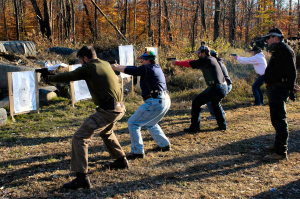 The goal of the Second Amendment Foundation Training Division's “Range Officer” course is to provide the student with a solid foundation in basic knowledge of range safety, various types of firearms actions, action malfunction types and understanding of range operations and how it relates to the safety of students and the public.
The goal of the Second Amendment Foundation Training Division's “Range Officer” course is to provide the student with a solid foundation in basic knowledge of range safety, various types of firearms actions, action malfunction types and understanding of range operations and how it relates to the safety of students and the public.
Range Officer is mandatory to become an instructor with the Second Amendment Foundation Training Division. This a one day class, conducted in a classroom facility and your participation in front of the class is required.
A number of topics will be covered in the “Range Officer" Course, these include but are not limited to:
- Range Setup
- Range Inspection
- Emergency Procedures
- Responding to Emergencies
- Range Rules
- Range Safety Briefings
- Running the Line and Movement on the Range
- Firearm Stoppages and Malfunctions
- Student Safety
- Instructor Safety
- Dealing with the public

